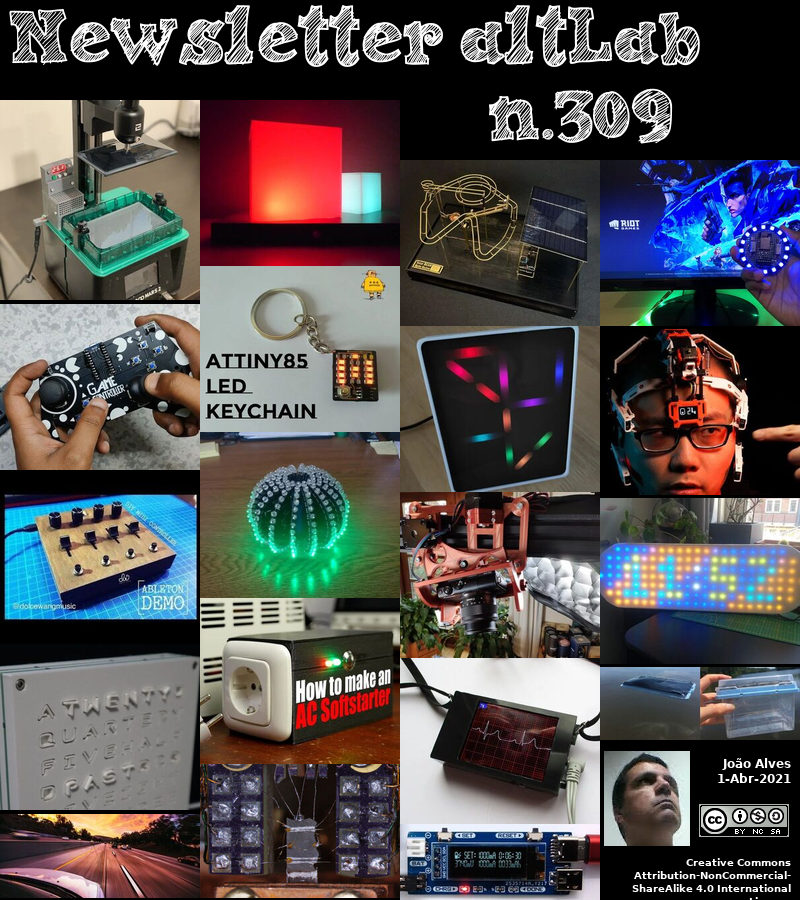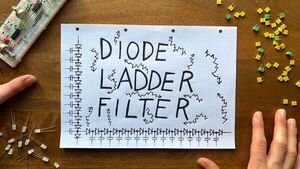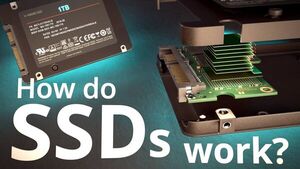2021-04-01 - Nº 309
Editorial
Esta é a Newsletter Nº 309 que se apresenta com o mesmo formato que as anteriores. Se gostar da Newsletter partilhe-a!
Todas as Newsletters encontram-se indexadas no link.
Esta Newsletter tem os seguintes tópicos:
Faz hoje anos que nascia, em 1776, a matemática francesa Sophie Germain. Ela ficou conhecida pelo seu trabalho em teoria dos números e contribuições para a matemática aplicada de acústica e elasticidade. Germain foi autodidacta por meio de livros e anotações de palestras fornecidas por amigos que frequentavam a Ecole Polytechnique, que ela, como mulher, não tinha permissão para assistir. Usando um pseudónimo masculino, M. LeBlanc, ela correspondeu-se com Lagrange, que reconheceu sua habilidade e, posteriormente, patrocinou o seu trabalho. Ela realizou uma prova limitada do último teorema de Fermat, para qualquer número primo abaixo de 100 onde certas condições foram satisfeitas. Em 1816, ela ganhou um prémio patrocinado por Napoleão por uma explicação matemática das figuras de Chladni, a vibração das placas elásticas.
Faz também hoje anos que nascia, em 1865, o químico austro-alemão Richard Zsigmondy. Ele recebeu o Prémio Nobel da Química em 1925 pela “sua demonstração da natureza heterogénea das soluções colóides e pelos métodos que usou, que desde então se tornaram fundamentais na química colóide moderna.” Os colóides são compostos de partículas sub-microscópicas dispersas dentro doutra substância. Para conduzir a sua pesquisa sobre colóides, ele inventou o ultramicroscópio (1903), com o qual ele podia ver partículas com um diâmetro de um 10 milionésimo de milímetro não visíveis num microscópio convencional Ele usava um feixe de luz intenso orientado numa posição perpendicular ao eixo óptico do microscópio. À medida que as partículas espalhavam a luz incidente, os seus movimentos podiam ser vistos como flashes contra um fundo escuro.
Faz igualmente hoje anos que nascia, em 1932, o cientista da computação norte-americano Norman Abramson. Ele criou a ALOHANET, a primeira rede de dados moderna, que formou a base dos protocolos essenciais na Ethernet agora amplamente utilizados. Foi inaugurada em 1970, operando a 9600 bits por segundo, usando rádio para fornecer uma rede de dados comutada por pacote sem fio entre várias ilhas do Havai. As suas inovações incluíram os primeiros sensores de pacote de rádio, os primeiros repetidores de pacote de rádio, a primeira rede de pacote de satélite e o primeiro acesso de rádio à Internet. As patentes americanas de Abramson incluem a primeira patente para verificações de redundância CRC para fornecer técnica de controle de erros de dados (nº 3.114.130) e a primeira patente emitida para o projecto de erros de ruptura em sistemas digitais (nº 3.163.848).
Faz também hoje anos que nascia, em 1933, o físico francês Claude Cohen-Tannoudji. Ele partilhou o Prémio Nobel de Física em 1997 (com Steven Chu e William D. Phillips) por desenvolver métodos usando luz laser para arrefecer gases até a faixa de temperatura do micro-kelvin (quase zero absoluto a uma fracção de milionésimo de grau .) O movimento dos átomos arrefecidos é, portanto, suficientemente lento para permitir o seu estudo com grande precisão, e sua estrutura interna pode ser determinada. Cohen-Tannoudji criou armadilhas a laser que operam por um processo que desde então tem sido chamado de arrefecimento de Sísifo. A Trabalhar com átomos de hélio, usando seis feixes de laser, ele atingiu a temperatura de 0,18 µK. Sob essas condições, os átomos de hélio diminuíram para uma velocidade de apenas 2 cm/s.
Por fim, faz hoje anos que nascia, em 1947, o matemático francês Alain Connes. Ele ganhou a Medalha Fields em 1982 (concedida em 1983) pelo seu trabalho em teoria dos operadores. As suas contribuições mais notáveis são (1) classificação geral e um teorema de estrutura para factores do tipo III, obtido em sua tese (1973); (2) classificação dos automorfismos do factor hiperfinito, que serviu de preparação para a próxima contribuição; (3) classificação dos factores injectivos; e (4) aplicação da teoria das álgebras C * às folheações e geometria diferencial em geral. O trabalho recente de Connes foi sobre geometria não comutativa e ele estudou aplicações à física teórica.
A 1 de Abril de 1960 era lançado o Satélite Tiros-1. Foi o primeiro satélite de observação do tempo, foi lançado do Cabo Kennedy e tirou a primeira imagem televisiva do espaço. Foi o primeiro de vários lançados no programa TIROS, nomeado a partir de sua função: Televisão por satélite de observação infravermelho, e foi o primeiro passo experimental da NASA para determinar se os satélites poderiam ser úteis no estudo da Terra. Naquela época, a eficácia das observações de satélite ainda não estava comprovada. Assim, várias questões de desenho para satélites foram testadas: instrumentos, dados e parâmetros operacionais. O objectivo era melhorar a aplicação de satélites para decisões relacionadas à Terra, como "devemos evacuar a costa por causa do furacão?" O TIROS provou ser extremamente bem-sucedido na previsão do tempo.
Faz hoje 45 anos que era fundada por três amigos a Apple Computer Company. Steve Jobs, Steve Wozniak e Ronald Wayne fundaram a empresa para desenvolver e comercializar o Apple I desenvolvido por Wozniak. Ronald desistiu ao fim de apenas 12 dias e vendeu a sua quota aos dois restantes membros. Nascia aqui uma companhia que quer se queira quer não tem criado um conjunto de tendências e de sistemas que ainda hoje são uma referência no mundo do IT.
Em 2004 era lançado o Gmail o serviço de correio gratuito da Google. Os utilizadores podem aceder ao Gmail na web e usando programas de terceiros que sincronizam o conteúdo do e-mail por meio dos protocolos POP3 ou IMAP4. O Gmail começou como uma versão beta limitada e encerrou sua fase de testes a 7 de Julho de 2009. Em Outubro de 2019, o Gmail tinha 1,5 mil milhões de utilizadores activos em todo o mundo.
Na Newsletter desta semana apresentamos diversas noticias, artigos científicos, projetos de maker assim como alguns videos interessantes. São também apresentados alguns modelos 3D que poderão ser úteis.
 João Alves ([email protected])
João Alves ([email protected])
O conteúdo da Newsletter encontra-se sob a licença  Creative Commons Attribution-NonCommercial-ShareAlike 4.0 International License.
Creative Commons Attribution-NonCommercial-ShareAlike 4.0 International License.
Outras Notícias

NASA’s Curiosity Mars Rover Takes Selfie With ‘Mont Mercou’
"The rover also snapped a pair of panoramas to create a 3D view of the stark cliff face featured in the selfie. At the start of March, NASA’s Curiosity Mars rover began approaching an impressive rock formation that scientists dubbed “Mont Mercou,” a nickname taken from a mountain in France. Standing about 20 feet (6 meters) tall, the outcrop is captured in all its majesty in a new selfie, as well as in a pair of panoramas that offer a 3D view. The selfie shows Curiosity in front of Mont Mercou with a new drill hole nearby at a rock sample nicknamed “Nontron” – the mission’s 30th sample to date. Curiosity’s drill powderized the sample before trickling it into instruments inside the rover so the science team could get a better understanding of the rock’s composition and what clues it might offer about Mars’ past. This area is at the transition between the “clay-bearing unit” Curiosity is departing and the “sulfate-bearing unit” that’s ahead on Mount Sharp, the 3-mile-tall (5-kilometer-tall) mountain that the rover has been rolling up since 2014." [...]

Samsung Develops New 5G Radio Technology for Efficient 5G Deployments in Mid-Band Spectrum
"New Samsung technology doubles bandwidth support of its mid-band portfolio, helping operators minimize hardware needs and simplify 5G rollouts Samsung Electronics has developed a new 5G wideband radio technology that expands bandwidth support for its next generation radios, including Massive MIMO radios, to help operators drive more flexible and cost-effective 5G deployments. With this new technology, Samsung will extend the bandwidth support of its 5G radios to 400MHz—double the 200MHz supported by its current commercial radios. With wider bandwidth support, Samsung’s radios will help operators maximize the utility of their mid-band spectrum for 5G networks, while using less hardware. The new technology will help operators minimize the number of radios required when managing spectrum in various deployment scenarios. This includes when an operator owns non-contiguous frequencies within 400MHz of bandwidth. Operators can also use this solution for RAN sharing, where they actively share network infrastructures with other operators through joint deployments." [...]

Army moves Microsoft HoloLens-based headset from prototyping to production phase
"Earlier today, the United States Army announced that it will work with Microsoft on the production phase of the Integrated Visual Augmentation System (IVAS) program as it moves from rapid prototyping to production and rapid fielding. The IVAS headset, based on HoloLens and augmented by Microsoft Azure cloud services, delivers a platform that will keep Soldiers safer and make them more effective. The program delivers enhanced situational awareness, enabling information sharing and decision-making in a variety of scenarios. Microsoft has worked closely with the U.S. Army over the past two years, and together we pioneered Soldier Centered Design to enable rapid prototyping for a product to provide Soldiers with the tools and capabilities necessary to achieve their mission. We appreciate the partnership with the U.S. Army, and are thankful for their continued trust in transitioning IVAS from rapid prototyping to rapid fielding. We look forward to building on this successful partnership with the men and women of the U.S. Army Close Combat Force." [...]

First nRF5340 modules eliminate processor trade-off for developers
"Single processor solutions will inevitably have to trade-off the processor's computational power against its efficiency. When that trade-off becomes too great, developers look towards dual-core solutions. Tomorrow’s commercial products will demand connectivity solutions to support advanced, highly-complex applications while also reducing time-to-market and development risk. Two cores better than one In a dual-core wireless SoC, one powerful processor with a high clock rate can be dedicated to the computational heavy lifting (and then switched off to save power until it is next needed). The other, a power-optimized processor with a slower clock, can be dedicated to wireless networking. Better yet, each core can also run its own software, preventing clashes between application code and RF protocol and allowing optimized algorithms for their destined processor." [...]

New RA6M5 Group from Renesas Completes Mainstream Line of RA6 Series Arm Cortex M33-Based MCUs
"New Group Delivers Extensive Communications Options, Flexible Memory Architecture and Strong Security for IoT Applications; Ideal for In-Field Firmware Updates Renesas Electronics Corporation (TSE:6723), a premier supplier of advanced semiconductor solutions, today announced the expansion of its RA6 Series microcontrollers (MCUs) with 20 new RA6M5 Group MCUs, completing the mainstream line of RA6 Series devices. The new parts offer a very wide array of communications options, generous on-chip memory, and Renesas’ best-in-class security features, enabling customers to create new and innovative IoT designs. The new MCUs offer numerous communication interface options, including CAN FD, Ethernet MAC with DMA, USB Full Speed and High Speed, and multiple serial interfaces. Designers of IoT systems will have unmatched flexibility in sharing critical data using the RA6M5 Group. The new MCUs integrate up to 2MB on-chip flash and 512KB on-chip RAM, enough to support a wide range of applications. They provide an OctaSPI interface that enables designers to extend the on-chip flash and RAM even more." [...]

Arm’s solution to the future needs of AI, security and specialized computing is v9
"Today, Arm introduced the Arm®v9 architecture in response to the global demand for ubiquitous specialized processing with increasingly capable security and artificial intelligence (AI). Armv9 is the first new Arm architecture in a decade, building on the success of Armv8 which today drives the best performance-per-watt everywhere computing happens. “As we look toward a future that will be defined by AI, we must lay a foundation of leading-edge compute that will be ready to address the unique challenges to come,” said Simon Segars, chief executive officer, Arm. “Armv9 is the answer. It will be at the forefront of the next 300 billion Arm-based chips driven by the demand for pervasive specialized, secure and powerful processing built on the economics, design freedom and accessibility of general-purpose compute.” The number of Arm-based chips shipped continues to accelerate, with more than 100 billion devices shipped over the last five years. At the current rate, 100 percent of the world’s shared data will soon be processed on Arm; either at the endpoint, in the data networks or the cloud." [...]

SpaceX launches Starship SN11 rocket prototype, but misses landing
"SpaceX's latest Starship prototype, SN11, took to the skies over Texas on Tuesday morning (March 30), following a 24-hour delay. That wasn't the first delay for the test. On Friday (March 25), SpaceX hoped to conduct the test flight after changing out one of the craft's three Raptor engines. Ultimately the test was moved to Monday and then finally happened early Tuesday morning, when the Starship SN11 rocket blasted off from SpaceX's Starbase test site near Boca Chica Village in South Texas at 8 a.m. local time (9 a.m. EDT, 1300 GMT). The rocket soared to an altitude of 6.2 miles (10 kilometers) before beginning the landing procedure. But at nearly six minutes into the flight, SpaceX's broadcast cameras cut out." [...]
Ciência e Tecnologia
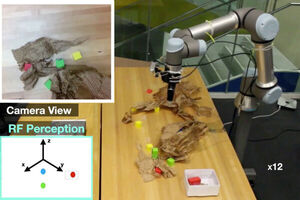
A robot that senses hidden objects
"System uses penetrative radio frequency to pinpoint items, even when they’re hidden from view. In recent years, robots have gained artificial vision, touch, and even smell. “Researchers have been giving robots human-like perception,” says MIT Associate Professor Fadel Adib. In a new paper, Adib’s team is pushing the technology a step further. “We’re trying to give robots superhuman perception,” he says. The researchers have developed a robot that uses radio waves, which can pass through walls, to sense occluded objects." [...]
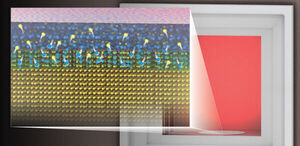
Breaking records like baking bread
"Researchers have made unparalleled ultrawide-bandgap semiconductors through temperature and timing, just like baking bread. Alloying, the process of mixing metals in different ratios, has been a known method for creating materials with enhanced properties for thousands of years, ever since copper and tin were combined to form the much harder bronze. Despite its age, this technology remains at the heart of modern electronics and optics industries. Semiconducting alloys, for instance, can be engineered to optimize a device’s electrical, mechanical and optical properties. Alloys of oxygen with group III elements, such as aluminum, gallium, and indium, are important semiconductor materials with vast applications in high-power electronics, solar-blind photodetectors and transparent devices. The defining property of a semiconductor is its bandgap, a barrier over which only electrons with the required energy can pass." [...]

How To Teach a Computer To Interpret Text
"A team of scientists from ITMO University has created a model for an algorithm that can analyze the meaning of texts. It differs from regular neural networks because it not only takes into account word usage frequency but also introduces a category of subjective text perception. Read on to find out what it means for the future of artificial intelligence and how quantum theory is of help here. Artificial intelligence (AI) is superior to the human mind in many ways. Since the middle of the 20th century, machines have been able to calculate faster than mathematicians. In 1997, a computer defeated grandmaster Garry Kasparov in a game of chess." [...]
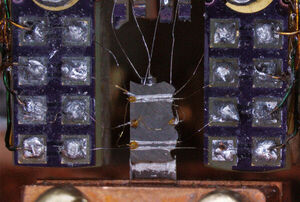
Uranium compound achieves record anomalous Nernst conductivity
"Colossal voltage results from interplay of material’s topology and strong electron correlations in a uranium-cobalt-ruthenium-aluminum alloy New research has demonstrated that a magnetic uranium compound can have strong thermoelectric properties, generating four times the transverse voltage from heat than the previous record in a cobalt-manganese-gallium compound. The result unlocks a new potential for the actinide elements at the bottom of the periodic table and point to a fresh direction in research on topological quantum materials. “We found that the large spin-orbit coupling and strong electronic correlations in a system of uranium-cobalt-aluminum doped with ruthenium resulted in a colossal anomalous Nernst conductivity,” said Filip Ronning, lead investigator on the paper published today in Science Advances. Ronning is director of the Institute for Materials Science at Los Alamos National Laboratory. “It illustrates that uranium and actinide alloys are promising materials to study the interplay among a material’s topology and strong electron correlations. We’re very much interested in understanding, tuning and eventually controlling this interplay, so hopefully one day we can exploit some of these remarkable responses.” The Nernst response occurs when a material converts a flow of heat into an electric voltage." [...]

Homing in on longer-lasting perovskite solar cells
"A new approach to identifying useful formulations could help solve the degradation issue for these promising new lightweight photovoltaics. Materials called perovskites are widely heralded as a likely replacement for silicon as the material of choice for solar cells, but their greatest drawback is their tendency to degrade relatively rapidly. Over recent years, the usable lifetime of perovskite-based cells has gradually improved from minutes to months, but it still lags far behind the decades expected from silicon, the material currently used for virtually all commercial solar panels. Now, an international interdisciplinary team led by MIT has come up with a new approach to narrowing the search for the best candidates for long-lasting perovskite formulations, out of a vast number of potential combinations. Already, their system has zeroed in on one composition that in the lab has improved on existing versions more than tenfold. Even under real-world conditions at full solar cell level, beyond just a small sample in a lab, this type of perovskite has performed three times better than the state-of-the-art formulations." [...]
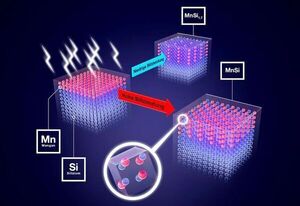
Pancake strategy for the win
"Special heat treatment improves novel magnetic material Skyrmions – tiny magnetic vortices – are considered promising candidates for tomorrow’s information memory devices which may be able to achieve enormous data storage and processing capacities. A research team led by the Helmholtz-Zentrum Dresden-Rossendorf (HZDR) has developed a method to grow a particular magnetic thin-film material that hosts these magnetic vortices. A central aspect of this new method is the abrupt heating of the material with short, very bright flashes of light, as the international team, consisting of scientists from HZDR, the Leibniz Institute for Solid State and Materials Research Dresden, TU Dresden (TUD), and Chinese partners, describes in the journal Advanced Functional Materials (DOI: 10.1002/adfm.202009723). In 2009, a research team had made a remarkable discovery: They found that tiny magnetic vortices can form in a material called manganese silicide – an alloy of manganese and silicon. Since then, these skyrmions, named after British physicist Tony Skyrme, have been considered promising candidates for future magnetic storage devices. They can be easily formed on and erased from surfaces and are no larger than a few nanometers (billionths of a meter), which makes them much smaller than the magnetic bits on today’s hard drives that measure about 50 nanometers." [...]
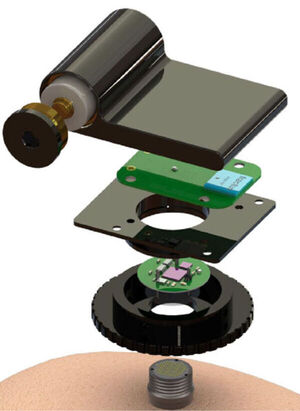
Researchers demonstrate first human use of high-bandwidth wireless brain-computer interface
"In an important step toward a fully implantable intracortical brain-computer interface system, BrainGate researchers demonstrated the first human use of a wireless transmitter capable of delivering high-bandwidth neural signals. Brain-computer interfaces (BCIs) are an emerging assistive technology, enabling people with paralysis to type on computer screens or manipulate robotic prostheses just by thinking about moving their own bodies. For years, investigational BCIs used in clinical trials have required cables to connect the sensing array in the brain to computers that decode the signals and use them to drive external devices. Now, for the first time, BrainGate clinical trial participants with tetraplegia have demonstrated use of an intracortical wireless BCI with an external wireless transmitter. The system is capable of transmitting brain signals at single-neuron resolution and in full broadband fidelity without physically tethering the user to a decoding system. The traditional cables are replaced by a small transmitter about 2 inches in its largest dimension and weighing a little over 1.5 ounces." [...]

A streamlined approach to determining thermal properties of crystalline solids and alloys
"MIT research team finds machine learning techniques offer big advantages over standard experimental and theoretical approaches. In a September 2020 essay in Nature Energy, three scientists posed several “grand challenges” — one of which was to find suitable materials for thermal energy storage devices that could be used in concert with solar energy systems. Fortuitously, Mingda Li — the Norman C. Rasmussen Assistant Professor of Nuclear Science and Engineering at MIT, who heads the department’s Quantum Matter Group — was already thinking along similar lines. In fact, Li and nine collaborators (from MIT, Lawrence Berkeley National Laboratory, and Argonne National Laboratory) were developing a new methodology, involving a novel machine-learning approach, that would make it faster and easier to identify materials with favorable properties for thermal energy storage and other uses. The results of their investigation appear this month in a paper for Advanced Science. “This is a revolutionary approach that promises to accelerate the design of new functional materials,” comments physicist Jaime Fernandez-Baca, a distinguished staff member at Oak Ridge National Laboratory." [...]

New early warning system for self-driving cars
"A team of researchers at the Technical University of Munich (TUM) has developed a new early warning system for vehicles that uses artificial intelligence to learn from thousands of real traffic situations. A study of the system was carried out in cooperation with the BMW Group. The results show that, if used in today’s self-driving vehicles, it can warn seven seconds in advance against potentially critical situations that the cars cannot handle alone – with over 85% accuracy. To make self-driving cars safe in the future, development efforts often rely on sophisticated models aimed at giving cars the ability to analyze the behavior of all traffic participants. But what happens if the models are not yet capable of handling some complex or unforeseen situations? A team working with Prof. Eckehard Steinbach, who holds the Chair of Media Technology and is a member of the Board of Directors of the Munich School of Robotics and Machine Intelligence (MSRM) at TUM, is taking a new approach." [...]

Molecules in Flat Lands: an Entanglement Paradise
"Within the realm of quantum mechanics, the generation of quantum entanglement remains one of the most challenging goals. Entanglement, simply put, is when the quantum state of each particle or a group of particles is not independent of the quantum states of other particles or groups, even over long distances. Entangled particles have always fascinated physicists, as measuring one entangled particle can result in a change in another entangled particle, famously dismissed as “spooky action at a distance” by Einstein. By now, physicists understand this strange effect and how to make use of it, for example to increase the sensitivity of measurements. However, entangled states are very fragile, as they can be easily disrupted by decoherence. Researchers have already created entangled states in atoms, photons, electrons and ions, but only recently have studies begun to explore entanglement in gases of polar molecules." [...]

Lab-made hexagonal diamonds stiffer than natural diamonds
"Nature’s strongest material now has some stiff competition. For the first time, researchers have hard evidence that human-made hexagonal diamonds are stiffer than the common cubic diamonds found in nature and often used in jewelry. Named for their six-sided crystal structure, hexagonal diamonds have been found at some meteorite impact sites, and others have been made briefly in labs, but these were either too small or had too short of an existence to be measured. Now scientists at Washington State University’s Institute for Shock Physics created hexagonal diamonds large enough to measure their stiffness using sound waves. Their findings are detailed in a recent paper in Physical Review B. “Diamond is a very unique material,” said Yogendra Gupta, director of the Institute for Shock Physics and corresponding author on the study." [...]

Sussex scientists develop ultra-thin terahertz source, paving the way to next generation of communication tech
"Physicists from the University of Sussex have developed an extremely thin, large-area semiconductor surface source of terahertz, composed of just a few atomic layers and compatible with existing electronic platforms. Terahertz sources emit brief light pulses oscillating at ‘trillion of times per second’. At this scale, they are too fast to be handled by standard electronics, and, until recently, too slow to be handled by optical technologies. This has great significance for the evolution of ultra-fast communication devices above the 300GHz limit – such as that required for 6G mobile phone technology – something that is still fundamentally beyond the limit of current electronics. Researchers in the Emergent Photonics (EPic) Lab at Sussex, led by the Director of the Emergent Photonics (EPic) Lab Professor Marco Peccianti, are leaders in surface terahertz emission technology having achieved the brightest and thinnest surface semiconductor sources demonstrated so far. The emission region of their new development, a semiconductor source of terahertz, is 10 times thinner than previously achieved, with comparable or even better performances." [...]
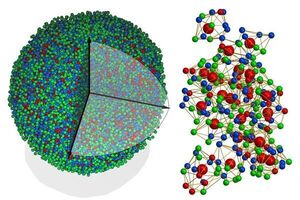
Century-old problem solved with first-ever 3D atomic imaging of an amorphous solid
"UCLA-led study captures the structure of metallic glass Glass, rubber and plastics all belong to a class of matter called amorphous solids. And in spite of how common they are in our everyday lives, amorphous solids have long posed a challenge to scientists. Since the 1910s, scientists have been able to map in 3D the atomic structures of crystals, the other major class of solids, which has led to myriad advances in physics, chemistry, biology, materials science, geology, nanoscience, drug discovery and more. But because amorphous solids aren’t assembled in rigid, repetitive atomic structures like crystals are, they have defied researchers’ ability to determine their atomic structure with the same level of precision. Until now, that is. A UCLA-led study in the journal Nature reports on the first-ever determination of the 3D atomic structure of an amorphous solid — in this case, a material called metallic glass." [...]

Optimized joining technology is opening the door to the safe use of hydrogen in the aviation industry
"Eco-friendly flying is on the horizon. All over the world, researchers are developing new technologies to achieve this goal. One focus of developments is the idea of using hydrogen-powered engines for aircraft in the future. The aircraft companies, though, face the challenge of storing this energy source. Hydrogen turns liquid when cooled to minus 253 degrees Celsius, and only then can it be used as a so-called cryogenic fuel. Both tanks and pipe systems in the aircraft have to be absolutely tight at such low temperatures." [...]

NTU Singapore scientists design ‘smart’ device to harvest daylight
"A team of Nanyang Technological University, Singapore (NTU Singapore) researchers has designed a 'smart' device to harvest daylight and relay it to underground spaces, reducing the need to draw on traditional energy sources for lighting. In Singapore, authorities are looking at the feasibility of digging deeper underground to create new space for infrastructure, storage, and utilities. Demand for round-the-clock underground lighting is therefore expected to rise in the future. To develop a daylight harvesting device that can sustainably meet this need, the NTU team drew inspiration from the magnifying glass, which can be used to focus sunlight into one point. They used an off-the-shelf acrylic ball, a single plastic optical fibre – a type of cable that carries a beam of light from one end to another - and computer chip-assisted motors. The device sits above ground and just like the lens of a magnifying glass, the acrylic ball acts as the solar concentrator, enabling parallel rays of sunlight to form a sharp focus at its opposite side." [...]

Quantum material’s subtle spin behavior proves theoretical predictions
"Using complementary computing calculations and neutron scattering techniques, researchers from the Department of Energy’s Oak Ridge and Lawrence Berkeley national laboratories and the University of California, Berkeley, discovered the existence of an elusive type of spin dynamics in a quantum mechanical system. The team successfully simulated and measured how magnetic particles called spins can exhibit a type of motion known as Kardar-Parisi-Zhang, or KPZ, in solid materials at various temperatures. Until now, scientists had not found evidence of this particular phenomenon outside of soft matter and other classical materials. These findings, which were published in Nature Physics, show that the KPZ scenario accurately describes the changes in time of spin chains — linear channels of spins that interact with one another but largely ignore the surrounding environment — in certain quantum materials, confirming a previously unproven hypothesis. “Seeing this kind of behavior was surprising, because this is one of the oldest problems in the quantum physics community, and spin chains are one of the key foundations of quantum mechanics,” said Alan Tennant, who leads a project on quantum magnets at the Quantum Science Center, or QSC, headquartered at ORNL. Observing this unconventional behavior provided the team with insights into the nuances of fluid properties and other underlying features of quantum systems that could eventually be harnessed for various applications." [...]

New nanotransistors keep their cool at high voltages
"Power converters play an essential role in electric vehicles and solar panels, for example, but tend to lose a lot of power in the form of heat in the electricity conversion process. Thanks to a new type of transistor developed at EPFL, these converters can perform at substantially improved efficiencies, especially in high-power applications. Power converters are the little-known systems that make electricity so magical. They are what allow us to plug in our computers, lamps and televisions and turn them on in a snap. Converters transform the alternating current (AC) that comes out of wall sockets into the exact level of direct current (DC) that our electronics need. But they also tend to lose, in average, up to 20% of their energy in the process." [...]
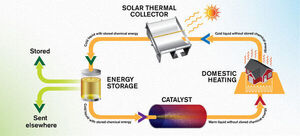
Emissions-free energy system saves heat from the summer sun for winter
"A research group from Chalmers University of Technology, Sweden, has made great, rapid strides towards the development of a specially designed molecule which can store solar energy for later use. These advances have been presented in four scientific articles this year, with the most recent being published in the highly ranked journal Energy & Environmental Science. Around a year ago, the research team presented a molecule that was capable of storing solar energy. The molecule, made from carbon, hydrogen and nitrogen, has the unique property that when it is hit by sunlight, it is transformed into an energy-rich isomer – a molecule which consists of the same atoms, but bound together in a different way. This isomer can then be stored for use when that energy is later needed – for example, at night or in winter. It is in a liquid form and is adapted for use in a solar energy system, which the researchers have named MOST (Molecular Solar Thermal Energy Storage)." [...]

Controlling bubble formation on electrodes
"Study finds the wettability of porous electrode surfaces is key to making efficient water-splitting or carbon-capturing systems. Using electricity to split water into hydrogen and oxygen can be an effective way to produce clean-burning hydrogen fuel, with further benefits if that electricity is generated from renewable energy sources. But as water-splitting technologies improve, often using porous electrode materials to provide greater surface areas for electrochemical reactions, their efficiency is often limited by the formation of bubbles that can block or clog the reactive surfaces. Now, a study at MIT has for the first time analyzed and quantified how bubbles form on these porous electrodes. The researchers have found that there are three different ways bubbles can form on and depart from the surface, and that these can be precisely controlled by adjusting the composition and surface treatment of the electrodes. The findings could apply to a variety of other electrochemical reactions as well, including those used for the conversion of carbon dioxide captured from power plant emissions or air to form fuel or chemical feedstocks." [...]
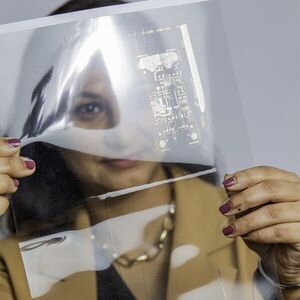
Deciphering the secrets of Printed Electronics
"We live in a world where we want our electronics to be flexible, bendable and stretchable apart from being intelligent. Printed electronics technology has emerged as the main route to enable this vision. A team of researchers from Aarhus University has now published a comprehensive review of its development that will enable researchers to address problems within this field. Next-gen electronics is envisioned to be non-rigid, component-free, flexible, bendable, and easily integrable with different objects. Direct-write printing techniques provide unique opportunity to enable this vision through use of nanomaterials, so-called functional inks, that can be tailored to add desired functionalities on various flexible substrates, such as textiles or plastic. The technology, known as Printed Electronics (PE), has been known for decades, but has recently gained considerable attention due to innovation in material inks, process technology and design revolution." [...]

Turning Wood Into Plastic
"Plastics are one of the world’s largest polluters, taking hundreds of years to degrade in nature. A research team, led by YSE professor Yuan Yao and Liangbing Hu from the University of Maryland, has created a high-quality bioplastic from wood byproducts that they hope can solve one of the world’s most pressing environmental issues. Efforts to shift from petrochemical plastics to renewable and biodegradable plastics have proven tricky — the production process can require toxic chemicals and is expensive, and the mechanical strength and water stability is often insufficient. But researchers have made a breakthrough, using wood byproducts, that shows promise for producing more durable and sustainable bioplastics. A study published in Nature Sustainability, co-authored by Yuan Yao, assistant professor of industrial ecology and sustainable systems at Yale School of the Environment (YSE), outlines the process of deconstructing the porous matrix of natural wood into a slurry. The researchers say the resulting material shows a high mechanical strength, stability when holding liquids, and UV-light resistance." [...]

Low-cost solar-powered water filter removes lead, other contaminants
"A new invention that uses sunlight to drive water purification could help solve the problem of providing clean water off the grid. The device resembles a large sponge that soaks up water but leaves contaminants – like lead, oil and pathogens – behind. To collect the purified water from the sponge, one simply places it in sunlight. The researchers described the device in a paper(link is external) published this week in the journal Advanced Materials. The inspiration for the device came from the pufferfish, a species that takes in water to swell its body when threatened, and then releases water when danger passes, said the device’s co-inventor Rodney Priestley,(link is external) the Pomeroy and Betty Perry Smith Professor of Chemical and Biological Engineering(link is external), and Princeton’s vice dean for innovation(link is external). “To me, the most exciting thing about this work is it can operate completely off-grid, at both large and small scales,” Priestley said." [...]

Go ahead for Dark Matter experiment
"CERN has approved the construction and operation of SND@LHC, a neutrino detector at the Large Hadron Collider. It's a precursor for SHiP, a detector meant to detect dark matter. Leiden physicist Alexey Boyarsky is one of the initiators of both SHiP and SND@LHC. Neutrinos are the shyest elementary particles known to exist. At this moment billions of them are shooting through each square centimetre of your body. Leiden astroparticle physicist Alexey Boyarsky hopes to generate neutrinos in these elementary particles in massive numbers, in order to detect them and investigate their properties." [...]
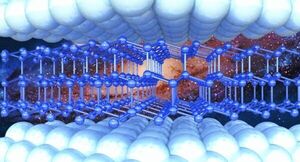
A Skoltech method helps model the behavior of 2D materials under pressure
"Scientists from the Skoltech Center for Energy Science and Technology (CEST) have developed a method for modelling the behavior of 2D materials under pressure. The research will help create pressure sensors based on silicene or other 2D materials. The paper was published in the ACS Nano journal. Silicene, which is regarded as the silicon analogue of graphene, is a two-dimensional allotrope of silicon. In its normal state, a bulk silicon is a semiconductor with a diamond crystal type structure. As it thins down to one or several layers, its properties change dramatically." [...]
Modelos 3D
Com a disponibilidade de ferramentas que permitem dar azo a nossa imaginação na criação de peças 3D e espaços como o thingiverse para as publicar, esta rubrica apresenta alguns modelos selecionados que poderão ser úteis.

Fully Customizable Foot
"Having trouble finding your feet? The furniture kind, that is! Whether you're replacing a missing foot or you need a complete set, you can now print your own with our fully customizable foot design. This part was designed several months ago to replace a missing foot on a footstool. We were unsure how well it would last, but it is still going strong, despite regular use, so we are sharing it for you to try. This design is completely free and shared under a permissive license." [...]
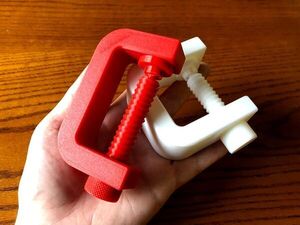
Adjustable Super Clamp
"This is an offshoot of my beefy 30mm glass clamp: https://www.thingiverse.com/thing:3072415 I will be playing with the OpenSCAD file over here in an attempt to make it even more customizable! I tried to break the red clamp by cranking it down to the kitchen counter as hard as I could and then pulling on the drawers it was blocking (see photos). It flexed a lot when being clamped and showed some stress on an inside corner but it seemed very strong and it didn't feel like it was going to give way. The clamp returned to it's normal shape and did not warp from being under that much pressure. I will try printing clamps with less thickness and run the same test to see how much difference it really makes. The original inspiration for making these stronger clamps was the popular "G-Clamp fully printable" that was quite easy to make fail when cranked down - deformation and bolt breakage." [...]
Projetos Maker
Diversos Projetos interessantes.
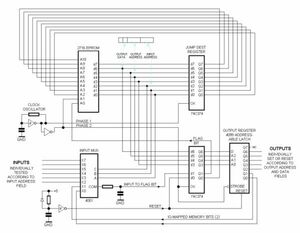
One-bit Computing at 60 Hertz
"This page describes a tiny computer made from an EPROM and a few logic chips. Although its specifications are ridiculously modest, the machine readily satisfied application requirements. - Clock Rate: 60 Hertz - Instruction Repertoire: 1 - Registers: 1 (a one-bit status Flag Bit) - I/O-mapped memory (not memory-mapped I/O) — 2 bits This is a design I came up with in response to a customer's request to add some new automated functions to a printing press. The new behavior might reasonably have been achieved using hardwired counters, gates and flip-flops, but I wanted to use programmable logic instead. (Later, when additional presses were modified, I switched to using a microcontroller.) This is not a Motorola MC14500 computer, but it was the MC14500 that introduced me to the idea of one-bit computing." [...]
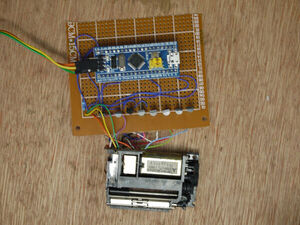
Using a Thermal Printer Mechanism
"The Casio CP-10 is a neat calculator that has a thermal printer attached. The calculator also has a built-in clock and can do useful tasks such as printing this month's calendar. The date rang eis also useful as it ends in 2099. The printer is a small mechanism that take standard 38mm thermal paper. I found out that the mechanism is the same one that the FP-12 printer uses. This is a small printer that is designed to attach to a variety of calculators and pocket computers." [...]
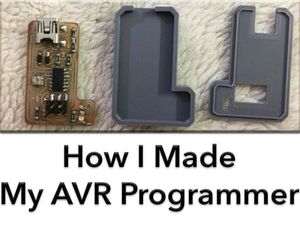
Tiny AVR Programmer
"Here you get your own very small AVR programmer board that you can put in your keychain. Today I will build an AVR programmer based on the FabOptimus that built by Ali Shtarbanov. It's very well documented and makeable at a fab lab. But, I wanna make a very small tweak. It has not a power indicator LED, So I will add mine. " [...]

Cellular Signal Heatmap with Raspberry Pi Pico and GPS
"Create a Google Map heatmap with cellular and GPS data acquired by a Raspberry Pi Pico and Notecard, using Python and Google Cloud Platform. A heatmap overlaid on satellite imagery is one of the more tantalizing means of displaying map-based data. Considering my newfound love for the Raspberry Pi Pico, and having seen how easy it can be to add cellular connectivity to the Pico, why not combine these loves in a new project? Today we are going to build a cellular- and GPS-enabled IoT solution that collects cell signal strength and location data at defined intervals, stored in the cloud, with a web app to display said data in a heatmap. Specifically we will be developing with: - Raspberry Pi Pico (any compatible MCU works fine too). - Notecard and Notecarrier from Blues Wireless (for cellular and GPS)." [...]
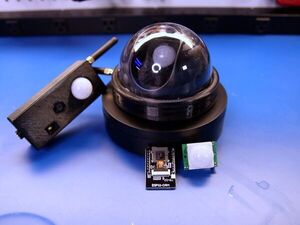
Discord Security Camera with an ESP32
"Use an ESP32 Cam and a passive infrared (PIR) sensor to create a motion-activated security camera that posts photos to a Discord channel. Use an ESP32 Cam and a passive infrared (PIR) sensor to create a motion-activated security camera that will post a photo to a Discord channel, where you have access to create a webhook. We'll build out the test circuit, using a breadboard and jump wire. We'll then build a wiring harness using Dupont connectors to allow for easy connections to the development board and PIR sensor. We'll then use our choice of a wall or ceiling-mounted 3D printed case to contain our parts and our camera. The ceiling-mounted camera makes use of an inexpensive decoy camera that can be purchased online." [...]

Live Energy Monitor
"We recently had a digital electricity (and gas) meter installed by Fluvius. In order to make more efficient use of our solar power, I installed a little dongle from HomeWizard to the P1 port of the meter. Using an app, it is possible to monitor electricity taken from or pushed to the grid. The idea is then to use the bigger appliances (dishwasher, washing machine, etc … ) when there is leftover solar power available, rather than push it to the grid. However, in order to not always have to consult the app to find the best moment to run appliances, I thought a live display would come in handy. It’s also the perfect opportunity for a new project after a long break from making and blogging." [...]

DHT22 Sensor with 16x2 LCD Screen
"Monitor Temperature & Humidity of a room on LCD Screen using Arduino Mega In this project, we are trying to monitor the Temperature and Humidity of a closed area like a Meeting/Conference room, Cabins, cubicles. So we have connected the temperature measurement sensor to the LCD screen with the help of an Arduino device. For this project, you need to download & install two libraries LiquidCrystal & DHT library. You can download those libraries from GitHub or directly from Arduino IDE" [...]
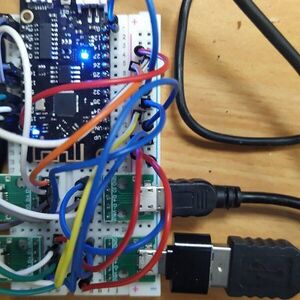
ESP32 usb software host
"Sofware usb host for connecting mouse , keyboard and joystick to ESP32 ESP32 software USB host through general IO pins. We can connect up to 4 USB-LS HID (keyboard mouse joystick) devices simultaneously. Pure software implementation of USB LS HOST stack for ESP32 chip. Now we can connect usb keyboard,mouse and joystick direct to ESP32 board" [...]
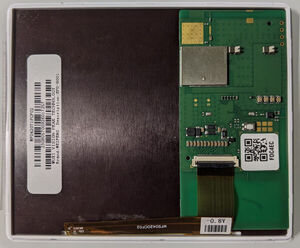
Hacking eInk Price Tags
"Repurposing boring eInk electronic shelf labels / price tags into useful photo frames / status displays, with blackjack and hookers custom firmware and greyscale! Quick video (partially sped up) here: [LINK]. There you can see association, image download with progress bar, and image display in greyscale + yellow. What they are and what they are for They have been appearing in stores since the early 2000s, but have really become prevalent in the last five to seven years! Also known as ESL (Electronic Shelf Labels), they basically allow the store to change prices dynamically as they see fit, without having to send a person out with a new printed piece of paper to place unto the shelf. The extra benefits include ability to show off more of the product's features (bullet point lists often shown on large price tags), change that shown feature list (advertise differently based on current day/month/etc), and use colors (last five years brought red and yellows to the previously only-black-and-white electronic shelf labels)." [...]

Hack Your Car With Wio Terminal and CAN Bus
"Hack your car and read the cycling speed, rotation speed, oil temperature and other information, displayed on the Wio Terminal screen. If you have some understanding of CAN Bus and Arduino programming, and want to hack your car, then this tutorial can provide you with a solution. As for why you want to hack your car, I don't know, but this is indeed an interesting thing. This project mainly used the Serial CAN Bus Module by Longan Labs and the Wio Terminal main control board by Seeed Studio. The OBD-II Serial CAN Bus Dev Kit is a CAN Bus control kit designed by Longan Labs. It uses UART to communicate with the single-chip microcomputer." [...]

A Tiny Logic Probe TTL / CMOS with Battery Charger
"Using an ATtiny1614 processor with LiPo battery, including USB charging circuitry and logic. It is programmable with Arduino IDE! I would introduce to you this Logic Probe, a complete instrument. It is simple but effective to measure digital logic levels 0 (zero) and 1 (one), both TTL and CMOS technology; the maximum accepted level is 10 volts but CMOS can reach up to 18 volts you would avoid. To use it just connect the Mini USB wire with black 'crocodile' clamp to the GND of your circuit and touch the probe where you want to know the logical level (in the same circuit) and look at the corresponding LED that will light up. Usually with Arduino and similar processors as ATtiny used in this project, we find TTL at 3.3v and 5.0v where the 'zero' and 'one' logical levels are the same: from 0.0 to 0.8v is considered as 0 (LOW) and from 2.0 to 3.3 up to 5.0v is considered as 1 (HIGH); between 0.8 and 2.0 is considered UNDEFINED." [...]
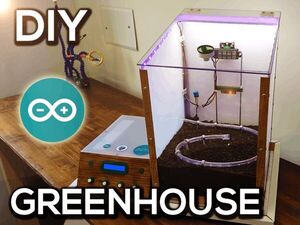
DIY home automation greenhouse
"Realization of domotic greenhouse with Arduino Uno completely do it yourself Hi, here is my latest project of the realization of the Domotic greenhouse with arduino uno. I decided to make it because having a domostic greenhouse is very convenient for growing plants in specific atmospheric conditions. The first thing to do is to get as much information as possible on how a greenhouse works but above all how to build it. Home automation greenhouse what is it? In addition to the automation of the environment, a domotic greenhouse allows the automation of fertilizer administration and irrigation automation. Furthermore, by monitoring environmental factors in a real-time way, there is the possibility of having an immediate intervention, avoiding crop problems." [...]

TinyCharger - Single Cell Li-Ion Battery Charger with Monitoring
"TinyCharger is an ATtiny25/45/85-based, single-cell Li-ion battery charger with selectable charging current limit (100mA - 1000mA) and an OLED display for monitoring. Hardware Power Connectors The device is equipped with a Micro-USB and a USB-C connector for power supply. Only one connector can be used at a time. The supply voltage must be 5V. Battery Connectors The device is equipped with a JST-PH 2.0mm socket and a 2.54mm pin header for connection to the battery. Only one battery can be charged at a time." [...]
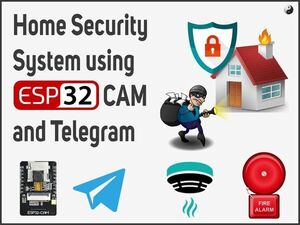
Home Security System using ESP32-CAM and Telegram App
"This project gives Intruder Alert, Door Open Alert, Gas Leak Alert, Smoke Alert and Fire Alert on Telegram Application. Overview In this project we’ll build a Home Security System using ESP32-CAM Which will notify us on Telegram App about any Intruder trying to break in our house by capturing and sending his photo to us. For that we’ve used motion and Door Sensors. We’ve also implemented Fire, Smoke and Gas Leak Alert system in this project. Objectives In this Home Security Systems project we're going to Monitor Doors - (to detect any Forced/Unauthorized Entry) Detect Motion - (for Intruder Alert) Sense Smoke/Fire/Flame - (to detect fire in house) Detect Gas leak For this we'll use Magnetic (Reed) Switch Door Sensors PIR Motion Sensor Module Flame/Fire Sensor Module MQ-6 Liquefied Petroleum Isobutane Propane Gas Sensor module Also ESP32-CAM Board has on-board camera, which we'll use to capture the Photo of Intruder. Hardware - Components To build this project we'll require AI Thinker ESP32-CAM Dev Board Mini PIR motion sensor (AM312) Magnetic (Reed/Switch) Door Sensor MQ6 Gas/Smoke Sensor Flame Sensor Module 10k Resistors – 2 Nos Logic Level Shifter Module FTDI programmer (to upload code) Breadboard MB102 MB102 Breadboard Power supply Board Jumper wires Battery 7.4V LiPo or Power Bank USB A to Mini USB Cable (To upload the code)" [...]

Cistercian Digital Clock
"Throughout history, people have invented and used many numeral systems, some well-known: the Sumerian, Roman, Indo-Arabic system (which by the way is used by almost all mankind). But there were also times when other systems were used. In this project I stopped at one of them, the one used by Cistercian monks and, of course, called the Cistercian numeral system . At the same time with this system, the Indo-Arabic system began to be used, which we finally know was imposed in use. But who knows? Maybe in a parallel universe it was kept together with the Indo-Arabic system also the Cistercian one and maybe is used in digital watches!" [...]
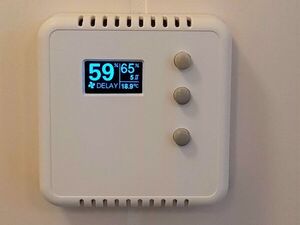
Bathroom Ventilation Fan Controller
"Now a few weeks in test and performing so well... ! An Arduino controller to *very effectively* keep the humidity to an acceptable level. WHY (oh why...?) Well I looked for a good solution to keep the humidity level down in our bathroom. We already have (already >20 years) a very good and silent S&P ventilation fan but it is operated manually and sometimes we forgot to turn it on and/or off. So looking around, I found there are only a few commercial options." [...]
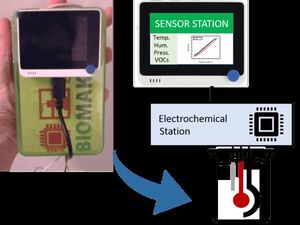
A Low-Cost Potentiostat for Sensing Applications
"We report a handheld, portable potentiostat with a user-friendly interface for electrochemical sensing using a wireless power supply. 1. Synopsis The development of reliable and low-cost electrochemical potentiostats is essential in the field of chemical sensors and biosensors. These potentiostats can be used for the calibration of sensors, and the use of such sensors for the testing of samples. Although there is a wide range of commercially available potentiostats that can be used for analysis and research nowadays, these options tend to be expensive, restricting their use. Within recent years, several low-cost potentiostats have been reported, employing simple designs with Op-amp amplifiers." [...]
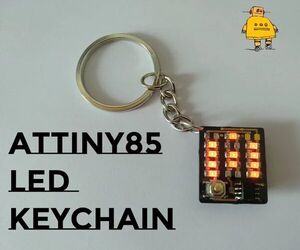
Attiny LED Letter Keychain
"Hello everyone! Today I am going to show you how to make a very cool LED keychain. To do this, we are going to use an ATtiny to make the LEDs blink and fade. This is going to help us to learn how to solder SMD components and also how to program an ATtiny. You can also find the code here in case you want to modify it or even create a new one! This code has 4 modes: All on, slow blink, fade and fast blink that change every time we press the button and then it enters in sleep mode to save battery." [...]

8x8 Haptic Wordclock
"I spent way too much time and money on this project but I am still happy with the result. One reason that it took me so long is a major mistake in the electronics design which I only realized rather late the other is that many of the mechanics are on the edge of what you can achieve with consumer FDM printers in terms of tolerancing and friction. The clock is driven by 64 magnetic actuators based on PCB coils. It has 2 mm travel and is latching in both positions, i.e. power only needs to be applied when switching positions. There are two other projects which inspired me to do this, first I saw a video of this 192px haptic display built by researchers from Switzerland to help blind people." [...]

Chamber Heater For Small Resin Printers
"This heater allows small machines such as the Elegoo mars to print with engineering resins like Siraya Tech BLU or specialty resins. Engineering resins require higher than ambient temperature to print with, 25 C is the bare minimum while optimal results require around 30 degrees. There are a couple of solutions on the market today, but all other chamber heaters are too large to fit the standard small printer. Other solutions such as putting a heater mat below the printer or putting a space heater in the room with the printer are extremely slow, taking around an hour or more to get up to temp. This resin heater can preheat the chamber to 10 C above ambient temperatures in around 12 minutes and reach a max temperature of 15 C over ambient in 45 minutes. It produces around 35 watts of heat and requires nearly no modifications to the printer itself, aside from trimming the rubber gasket of the enclosure." [...]

The KeebCard, an open-source, low-power, mechanical switch computer keychain
"This is the home of the KeebCard project. Originally designed as a business card, people loved it so much I decided to release a version of it as open-source (TODO: add a license). The KeebCard is centered around an SSD1306-powered 128x32 monochromatic display and an ATTINY85-10SU. The code uses the wonderful Tiny4kOLED library to communicate with the screen via i2c. With 8 kilobytes of program space and 512 bytes of RAM, it's a fun challenge getting anything to run on this thing! " [...]
DIY USB Midi Controller With Arduino: a Beginner's Guide
"I love MIDI Controllers! They are some of the coolest yet most powerful devices for controlling mixed media - traditionally used to connect to music software (like Ableton Live) to play virtual instruments as well as control effects - but can also be used with VJ software (like Resolume), and even lighting control programs (like Lightjams)! If you haven't already, check out the above video to see the finished DIY MIDI controller in action with Ableton! ☝️☝️ And as a bonus, here's me VJ'ing using the controller. The exercise of completing this project helped me to gain the skills to grow from a Novice Tinkerer to at least an Intermediate one. It really got my feet wet in the world of Arduino, electronics, and even some product design." [...]

Timer With TM1637 and Arduino
"This timer is useful in both domestic and industrial applications. It is a countdown timer programmable in the range of 1s .... 9999s. During this time, the load is powered by a relay on the board. For repeated timings, it is possible to memorize the timing duration (MEM LED on). The end of the period time is signaled acoustically with a Beep and optically by turning off the LOAD POWER LED. It is a compact module, not very big and can be easily made." [...]
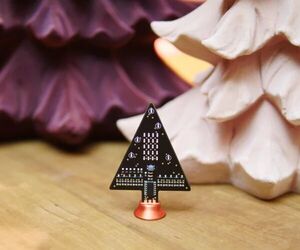
Matrix-Tree
"It was December 2020, deep into the second Covid-Lockdown and I thought about how to give away some smiles for christmas to my family and friends. Besides, I wanted to have some fun with pcb-layout and microcontrollers. The result: This cute small and relatively simple tree pcb with a Attiny44 and a 4x5 fully customizable led-matrix. The reviews: 16/29: "This was the best christmas gift this year and you stole the show for everyone else." 10/29: "No chance you made this yourself only for us!" 02/29: "Can you make it go slower?"" [...]

Automated Overhead Camera Assistant for Instructional Videos
"Have you ever wished you had an extra pair of hands in the workshop to handle the camera, while you were concentrating on your project ? This build tries to help with this, by providing an automated camera assistant, that can automatically move between learned keyframe camera positions, or alternatively continuously pan between them from above your workbench. This adds depth to the project you are working on, and engages the viewer. Most of the videos below are shot with the camera assistant where it continuously pans between keyframes. This meant I had two make an extra Camera Assistant in order to film the making of it, which gave me opportunity to double check my own instructable :) Only the videos of electronics are filmed with a static camera position, as I only had one controller at hand. " [...]

STOP Face Touching Device
"Why do you want to stop touching since it is part of our human nature? Well, it is all because of the virus floating around. Health officials keep telling the public to stop touching faces when they couldn't help. So I decided to use some technology to help. Supplies: Hardware M3 Hex socket head screw M3 Flat head screw 2/56 screw Spring Kit Washer Kit Electronics Arduino Nano 7 Segment display IR Sensor TT Motor OLED display Protoboard Kit Jumper Cable Kit 3D Printer A5S Hatchbox PETG Water Decal Paper Elastic band" [...]
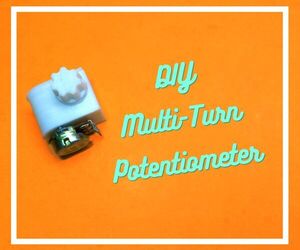
DIY Multi-Turn Potentiometer (Using Worm Gear Mechanism)
"We tinkerers have used potentiometers whether it is of a buck-boost converter or simple audio amplifier, and at some point, we struggled with controlling it precisely. We can get trim pots but setting those regularly is not so easy. Also, there are multi-turn potentiometers available in the market but they are generally expensive and only available in a limited range of values. So in this Instructable, I will show you how I made a simple mechanism that can be used to turn any potentiometer into a multi-turn potentiometer. " [...]

DIY Game Controller
"Hey everyone what's up... so this is my DIY Game controller. It uses an Arduino Pro Micro which runs with HID Function, this is actually the second version of my previous game controller which had buttons but this one has two joysticks. unlike the previous version, this one runs on the Joystick library which converts this pro micro into a proper gamepad controller... fun fact, this controller can also run Retro games, like doom and donkey kong, by hooking it up with a retro pi/ or Recal pi setup... more about that later. In this Instructables, I'm gonna show you guys how you can build your own game controller in few easy steps so without any further ado, let's get started! Supplies: these are the things that I used for this project- Custom PCB Switches Verticle switches Analog joystick Pro micro Female Header Pin" [...]

STM32-based Custom Gaming Keypad With RGB (Originally Made for Osu!)
"What is this? This is a custom gaming keypad with four hot-swappable mechanical keys and customizable RGB LEDs. It is powered by an STM32F103Cx microcontroller and is programmed through the Arduino IDE. Its keys can be programmed on the fly through the driver program provided or through composite serial communication. Feature List: Fast STM32F103Cx microcontroller allows for low input latency. USB Full Speed with 1000hz polling rate." [...]
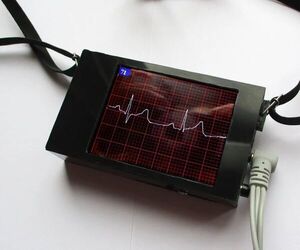
ECG Display With Arduino
"This ECG (Electrocardiogram) unit has an integrated display. The display can show individual heart beats in a large format, the train of heart beats in a small format and a Poincar plot. It is battery powered and can be worn round your neck on a lanyard. It is built from an AD8232 module (7 with leads), an Arduino Nano (3) and a 2.8" TFT display (6) plus a few resistors, a pushbutton and so on - the sort of things you already have. For power, you can use 4 AA cells or a single Lithium cell. You might be interested in your heart during the Covid-19 pandemic." [...]
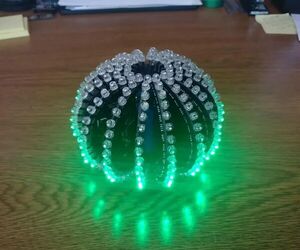
RGB LED Sphere
"This is my RGB LED Sphere project, it certainly is not the first, but I had to have one & all the crowd funded attempts failed so I decided to build one myself. There are 16 slices total & two circular PCB's at the top & bottom where all the slices fit into. Each slice contains 19 WS2812 "NeoPixel" digitally addressable LED's per slice for a grand total of 304 RGB LED's per sphere. The sphere is controlled by a single slice that contains an Atmega328, the same MCU as an Arduino Uno. The control slice also contains an accelerometer, Lithium Ion booster/charger, and a push button to switch between animations. Each slice has an 3 inputs & an 3 outputs, (5V, GND, LED SIGNAL), each slice connecting to the next." [...]

Dual Cores & Interrupts on Pi Pico
"The new Raspberry Pi Pico offers Dual Cores and Interrupts if you use MicroPython. I thought I would give it a go and try explain some of the pitfalls to avoid. This project keeps the action running on the two cores very simple, so that we can concentrate on new aspects of the code: setting up and activating the coresshutting down the cores in sequence using interrupts The video shows this simple example, with a rapid, on screen, count running on Core 0 and blinking/ moving LEDs on Core 1. The first core begins counting but does not start the second core until the count has got to 30, so we can see that it does not slow down as the LEDs start moving. The two buttons offer control. The first button changes the direction of movement of the blinking LED each time it is pressed." [...]
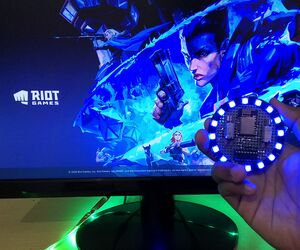
Gamer Assist Haptic Feedback System for Games Using Esp8266
"So, in this video we’ll be seeing how to build this haptic feedback device and the ambient light system which reacts to the player's health value inside a PC game! For that we’ll be using the ESP-NOW protocol, about which we learnt in the previous video and also see how to use different RGB LEDs and different libraries to drive them. Finally a little bit of python and open cv to get the data from the game. Supplies: These are the list of products which can help you do this project with ease (Affiliate Link) Esp12E Haptic motor(exact one) Haptic motor(alternative) 3.3V regulator (smaller capacity) 3.3V 800mah (1A) Velcro Header Pins Angled Header Pins Wires FTDI PCB Soldering Gun Soldering Lead Foam sheets screw terminal Resistor Tp4056 Boost LED Strip RGB ring Node MCU Breadboard + power supply 7805 DC jack" [...]
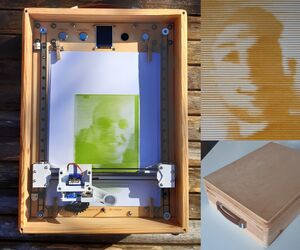
Portable Portrait Painter
"Introduction There are probably over one-hundred Arduino based plotting machines on the internet with instructions available on how to make them. What makes this one unique (as far as I know), is the inbuilt camera and screen. Other plotters must be connected to a computer. This one works completely independently. The 20fps video shown on the screen makes it easy to capture pictures with the camera, then just press the paint button to have a watercolour portrait in less than 5 minutes. Thanks to Indrek Luuk who wrote the camera/video code and to Sourav S who solved how to read information from the screen (written permissions obtained for contest entry)." [...]

DIY Unusual Arduino Linear Clock
"This is another one of my series of unusual clocks. The time is displayed on the WS2812 LED strip containing 34 LEDs. Hours, decadic-minutes and minutes each have their own color. Device is really simple and contain only a few components: - Arduino Nano microcontroller - WS2812 RGB Led strip containing 34 Leds - Three momentary switches for setting the clock - And 3 Pull_up resistors The way the time is displayed is as follows: The first group of 15 LEDs shows the hour. The second group of six diodes shows the tens of minutes, and The third group of 12 LEDs shows the minutes. For easier reading, all groups are divided into subgroups of 3 LEDs each." [...]
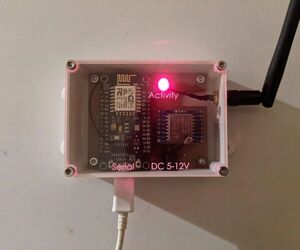
IoT LoRa Sensor Module and Gateway
"Ever wanted to know the temperature of your house everywhere in the world ? Want to add a feature to your weather station, or monitor the air of your workshop ? Let's have a look to this instructable ! This project is initially designed for internet of things (IoT) purposes. There is a Sensor Module measuring different ambient variables, this module sends its measurements through LoRa to a Gateway Module, which itself sends its data to the internet. The modules are based on Arduino." [...]
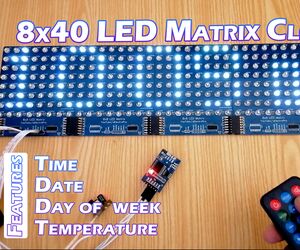
8x40 LED Matrix Clock Using DS3231 RTC Module and Arduino
"In this article I will show to how to make LED Matrix Clock. This clock uses DS3231 real time clock module that provide the precise time. It can display Time, Date, Day of week and Temperature. We can also update its time using Infrared TV remote. Let's get started! " [...]

How to Make a Wooden Engraving Pantograph
"A pantograph is a simple series of levers of a set length that can be used to enlarge or reduce and existing shape. Very often used for drawing, this version is a small & cheap DIY version of the typically larger and more expensive engraving pantographs that can be bought. The engraving pantograph differs in design from a drawing pantograph (often used with pencils) in that for a drawing pantograph, either the tracing point or the pencil (depending on if you are enlarging or reducing) will coincide with one of the pivot locations. As we are using this for engraving with a Rotary Tool for engraving, this would make it much more complex, so to avoid this, I have moved the position of the Rotary Tool away from the pivot allowing us to use a very simple pivot. This changes the geometry of the levers slightly but makes the pivot design and mounting the Rotary Tool much simpler whilst still getting the same result. A pantograph can be used to either enlarge or reduce, for this design I have chosen to make it reduce only, for a number of reasons; Due to the simple pivots I'm using, accuracy won't be as good as it could be and when enlarging and errors are magnified, which depending on how loose the pivots are, might be visible in the enlarged engraving." [...]
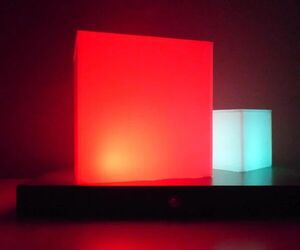
Illuminated Cubes
"This project is a follow up of the Illuminated Presents project that I posted earlier. My wife really liked the Illuminated Presents but kept them as Cubes and did not put a bow around it to turn them into presents. Because of this success I created a second one – called Illuminate Cubes since that is what they are – but now using different Cube sizes. This version has the same functions as the previous project: Control 2 Cubes at the same time using one PIC12F617 microcontroller. The microcontroller software was written in the JAL programming language Switch the Cubes on and off using a push button Randomly change the color of the Cubes by fade-in and fade-out of the colors red and green Switch off the Cubes when the battery voltage drops below 3.0 Volt. This will prevent the rechargeable batteries from being discharged too much After fading-in one color, the LED stays on for a time somewhere between 15 seconds and 30 seconds." [...]

How to Make an AC Softstarter
"In this project I will show you why my new autotransformer keeps tripping my circuit breaker and how I built an AC softstarter in order to "softly" start the transformer so that it does not trip my circuit breaker. Along the way we will find out how exactly this problem gets created and how you can fix it easily. BTW, such softstarters are also useful for motors ;-) Let's get started! " [...]
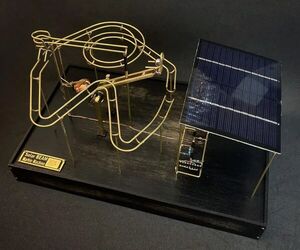
Solar BEAM Marble Machine
"Ladies and gentlemen, I present to you, my marvellous "Solar BEAM Marble Machine"! A brass marble machine with a solar powered, solenoid actuated, lever lifting mechanism! This machine uses capacitors to store energy from the sun and, once charged, dumps all that energy into a coil, pushing away a magnet, and lifting a small steel ball through the use of a lever. In previous BEAM related Instructables there was some confusion surrounding my use of the term BEAM. I don't think it is such a common concept anymore. How I understand it is that BEAM is a hobby electronics movement from the late 90s to early 00s that focused on turning found or common components into analogue circuits and robots." [...]
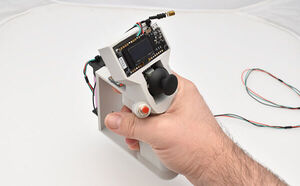
DIY Motion Controller
"DIY Motion Controller is a gesture control controller that works with any drone or RC airplane. It acts as an OpenTX trainer slave connected to the OpenTX radio like a Radiomaster TX16S or any other with SBUS trainer input. Drone or airplane should be capable of Position Hold and Altitude Hold. INAV or Ardupilot recommended. " [...]

Animated LED Clock
"Bored with Pandemic lockdown like the rest of us I started playing around with Arduino and LED strips. I soon ran into the "ping pong ball LED clock" by thomasj152 at https://www.instructables.com/Ping-Pong-Ball-LED-C... and decided to give it a try. Now after many (way too many!) hours of learning and messing around I thought I'd publish the changes I have made to it - while the concept and execution is roughly the same, I ended up rewriting much of the software so that it is (I think) more flexible and quite different. Two major changes were made: - I replaced the ping pong ball diffusers with cloth. The effect isn’t quite as funky but it’s easier and shows how the LED’s are on a grid, instead of making it look like a hex pattern - The software was largely rewritten to make it more flexible and allow for sprite - based animations I ended up coding not just a clock but something that is almost a 23x7 pixel full colour LED display, with a set of different animations." [...]
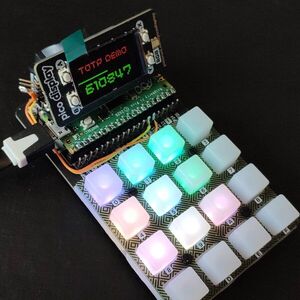
Picoth - 2FA Auth with Pi Pico
"An easy to use yet secure 2FA gadget, using a Raspberry Pi Pico and RGB Keypad, MicroPython. 2FA has quickly become an easy to implement solution for all online services willing to add extra safety to user accounts. As a result, users are now overwhelmed with 2FA requests for anything. I need them for Github, Discord, Hosting account, Online shops, bank and exchanges... For one, I don't feel comfortable with all these keys only stored physically on my phone. Then, It's a pain for me to unlock, open Google authenticator, scroll to the right item in the ever growing list aso... For long, I searched some nice and ready made hardware that would allow me to handle that in a more user friendly way. Then I saw Pimoroni's RGB Keypad." [...]
Secção Videos
Videos interessantes.
That's all Folks!



